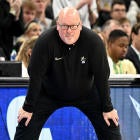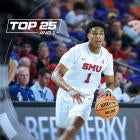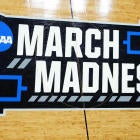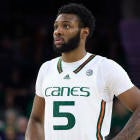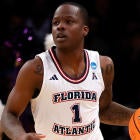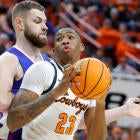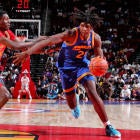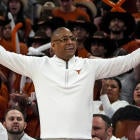The three teams that finished last in the Big Ten league standings last season -- Illinois, Minnesota, and Rutgers-- all have the requisites to be significantly more competitive than they were a year ago and other teams in the Big Ten, notably Iowa and Maryland, lost several key pieces.
Illinois, Minnesota, and Rutgers were a combined 8-46 in regular season league play and those numbers should be drastically different next season.
Why?
The Illini are still awaiting word on the status on several of their players for next year, most notably Kendrick Nunn (suspension), but should be a postseason team as long as they can stay healthy.
John Groce underwent a new level of Murphy's Law last year as his starting point guard (Tracy Abrams), power forward (Leron Black), and center (Mike Thorne) were lost for the season due to injury.
Black will miss the first four games of next year due to suspension, but Abrams is expected to back as the Illini's starting floor general.
Illinois also returns an All-Big Ten player in Malcolm Hill, a potential star in sophomore guard Jalen Coleman-Lands (10.3 points in 15-16), and a capable role player in 6-10 big man Michael Finke.
Minnesota meanwhile, has had some off-the-court issues recently with big man Reggie Lynch (suspension), but still possess enough to make a leap towards the middle of the conference standings.
Richard Pitino adds a top-40 freshman in Amir Coffey and two potential perimeter starters in Milwaukee transfer Akeem Springs (13.2 points in 15-16) and Texas A&M transfer Davonte Fitzgerald to go with a strong one-two punch of Nate Mason and Jordan Murphy.
And Rutgers?
Well, Rutgers is going to be better because frankly it can't be much worse.
What does all this mean?
The Big Ten is looking like it's going to be in tiers next season.
Wisconsin, Indiana, Michigan State, and potentially Purdue if Caleb Swanigan returns will be at the top with a host of other programs bunched up behind them.
Iowa and Maryland will each have a completely different look in 2016-17 while Ohio State and Michigan both return key pieces from last year, but they don't look like vintage Ohio State and Michigan either.
That leaves Northwestern, Nebraska, and Penn State-- which added an elite recruiting class -- left to battle things out in the league standings, which look wide open after the first three or four teams.
If you're a program in the Big Ten that's had its share of rough years, next season is the time to make your move.
Syracuse needs Tyus Battle to be elite as a freshman
The worst kept secret in college basketball circles right now is that Malachi Richardson will stay in the 2016 NBA Draft.
What does that mean for the Orange heading into next season?
Tyus Battle has to be good right out of the gate as a freshman. And at times, he has to be great.
The four-star wing was recruited by Syracuse to play a major role for the Orange during his first year of college basketball, but I'm sure when Jim Boeheim looked at his blueprint for the 2016-17 season he figured that Battle would be on one wing and Richardson would be on the other.
Now those plans have likely changed.
Fresh off a remarkable run to the Final Four, Syracuse is on the verge of losing three perimeter starters -- Richardson, Michael Gbinije, and Trevor Cooney -- who logged the majority of minutes last season in the back court.
The Orange are going to need Franklin Howard (1.6 points as a freshman) to make a major jump as a sophomore and also need reliable mileage from graduate transfer John Gillon (13.2 points last season) in addition to an elite freshman year from Battle.
Syracuse returns Tyler Roberson, Tyler Lydon and DaJuan Coleman up front while adding 7-foot-2 Providence transfer Paschal Chukwu and four-star power forward Matthew Moyer.
The Orange have ample pieces on the baseline to stifle opponents within the confines of their 2-3 zone, but college basketball has always been a guard's game and nobody knows that better than Boeheim.
He'll need consistent play from a fifth-year transfer (Gillon), a huge jump from a player who only made two 3 -point shots last season (Howard), and a monster freshman season from an elite recruit (Battle) to have his team in the top third of the ACC.
The Portland Trail Blazers are proof that mid-major guards don't need to "transfer up"
I'll be the first to admit that I'm not the world's biggest NBA fan because so much of my time is spent consuming the college game, but Portland's playoff run reiterates the importance of evaluations in basketball.
The Trail Blazers fell to Golden State in a five-game series that was much closer than a 4-1 margin indicates and did so largely in part thanks to play of two guards -- Damian Lillard and C.J. McCollum -- who each played college basketball at the mid-major level. Lillard attended Weber State while McCollum went to Lehigh.
These two players each averaged over 20.0 points during the series against Golden State and reiterated that college players don't always have to "transfer up" if they aspire to play at the highest level.
During this off-season we've seen Cane Broome transfer from Sacred Heart to Cincinnati and Dylan Smith leave UNC-Asheville for Arizona.
There's nothing wrong with wanting to experience college basketball at the highest level, but the play of both Lillard and McCollum shows that there's many different routes to take if you want to play in the NBA.
Just ask all the pro scouts and general managers who are currently raving about Saint Joseph's wing DeAndre Bembry after watching him this past week in Chicago during the NBA Draft Combine.
Bembry didn't play in a power-five league, but knows how to make the simple plays at the right time and is as unselfish as any player in the 2016 NBA Draft.
NBA teams spend lots of time between now and late June doing their homework on prospects in an effort to gain as much information as possible so that they can decide if someone is the best fit for their specific organization.
Portland's success is proof that those players can come from the mid-major level: not the starting point of most NBA stars, but one that's possible with a correct evaluation or two.
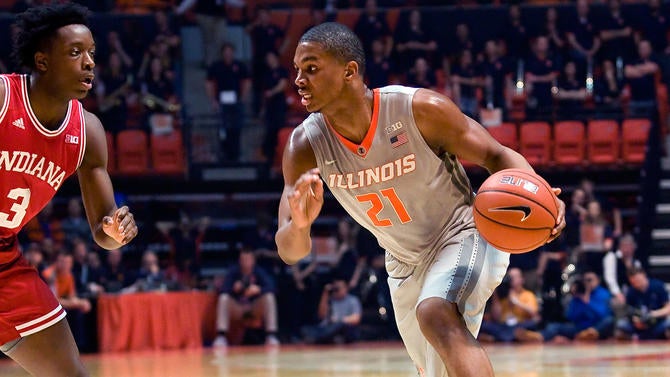
This and That:
- There's still no official timetable on when 2016 big man Jarrett Allen will make his college decision, but sources have told CBS Sports that Houston has "a real serious chance" to land the 6-10 big man. A McDonald's All-American, Allen will choose between the Cougars, Texas, and Kansas. The Austin native is a "make or break" piece for both Kelvin Sampson and Shaka Smart entering next season.
- Looking for an under-the-radar newcomer in the ACC? Try Florida State's Braian Angola-Rodas. The 6-6 wing averaged 21.4 points, 6.5 rebounds, and 4.3 assists last season in junior-college and is the favorite to replace Malik Beasley in the Seminoles' starting lineup.
- Word out of the Atlantic 10 meetings this past week in Naples is that the league is likely going to stay at 18 conference games instead of switching back to 16. An 18-game league schedule has been in place for each of the last two seasons and the Atlantic 10 only had a combined six bids in each of the last two NCAA Tournaments. During the two years prior, a 16-game league schedule led a combined 11 bids. Just saying.
- South Carolina and UMass will start a home-and-home series beginning next season, in Columbia, sources told CBS Sports. There will be a return game in Amherst during the 2017-18 season.
- One quick thought on the NBA Draft Combine: why do the results of pseudo pick-up games and "one-on-none" individual drills often usurp a player's production during the previous college basketball season? It doesn't make any sense to me either.













